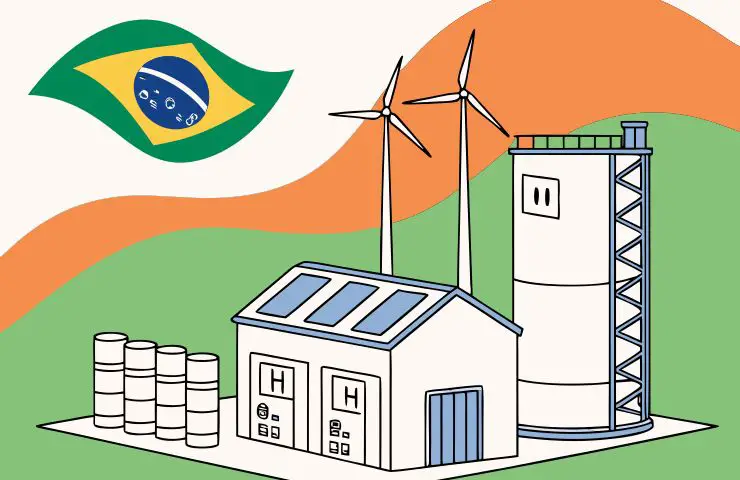
Green Hydrogen Brazil: ABIHV Demands Veto of Energy Additionality in Electricity Sector Reform
November 10, 2025In Brazil’s vast energy scene — home to more than 215 million people and boasting a renewable energy portfolio heavy on hydro, solar and wind — there’s a heated tussle over green hydrogen Brazil and how best to turbocharge its roll-out. Come May 21, 2025, the federal government unveiled a massive electricity sector reform under Provisional Measure No. 1,300/2025. Its goals? Amp up competition, broaden consumer choice and push Brazil further down the path of decarbonization. But tucked inside is an energy additionality clause that’s got the ABIHV up in arms. Depending on who you ask, this could either be the secret sauce for clean growth or a real roadblock to Brazil’s ambitions in the global green hydrogen market.
A Game-Changer for Brazil’s Energy Transition
Let’s face it: Brazil’s grid is already a poster child for renewables, with over 80% of its electricity coming from zero-carbon sources. Yet MP 1,300/2025 is the first major shake-up in years to slap new duties on big self-generators — and that includes industrial-scale hydrogen hubs. Beyond the catchy bullet points like fairer tariffs for low-income families or letting more folks shop around in the low-voltage market, there’s a hidden MVP here: making sure green hydrogen actually bankrolls fresh renewable capacity. Sounds logical, right? But nailing that balance is trickier than it looks, and the ABIHV veto plea shows just how high the stakes really are. Can policy keep pace with the breakneck innovation in the green hydrogen Brazil sector?
Think of Brazil’s Northeast as a sun-soaked powerhouse and its coastline as a wind buffet. Investors are lining up, eyeing export markets, and with per capita income around USD 9,680, the country seems poised to flex its muscles on the global stage. Yet, the energy additionality clause — which forces producers to tie up with brand-new solar or wind farms instead of existing ones — could trip up projects just as they’re hitting full stride. With Congress on a tight 60-day clock to weigh in, it’s not just a paperwork problem; it could make or break investors’ confidence and, by extension, Brazil’s climate goals.
Understanding the Energy Additionality Criterion
At its core, the energy additionality rule aims to guarantee that green hydrogen doesn’t simply steal power from current renewable plants. The goal? Add real, extra gigawatts of clean energy to the grid every time you fire up an electrolyzer. In theory, everybody wins. In practice, though, it feels like adding another maze of boxes to tick off. Companies now face a dual test: prove you’ve backed new generation and time it right with your hydrogen offtake. That’s a scheduling headache that could drag out timelines and jam up contracts.
To make it stick, producers must dance through a certification system, meticulously log generation data and lock in long-term power purchase agreements (PPAs) that point only to recently built projects. That’s extra paperwork piled on top of the engineering feats needed to scale next-gen electrolyzers. For ABIHV members — from producers to tech suppliers and buyers — that translates to heftier upfront bills and tighter limits on where they get juice. Is additionality a bad idea? Not inherently, especially since parts of Europe and Asia have similar rules. It’s more a question of timing and fit for Brazil’s sprint towards a robust renewable energy policy.
Why ABIHV is Leading the Charge
The ABIHV isn’t just grumbling in the corner; they’ve laid out three big concerns: ballooning project costs, tangled red tape and a hit to Brazil’s competitive edge. First up, tying hydrogen plants to freshly minted renewables means dropping more capex on extra infrastructure. Second, you’ve got to tango with federal bodies, grid operators and cert agencies — each with their own rulebook. Third, there’s a real fear that while Brazil’s green hydrogen bucket list grows, buyers in Europe and Asia might get antsy waiting for supply assurances.
But ABIHV isn’t simply waving a red flag; they’ve brought amendments to the table. Imagine a transitional window letting early-stage projects draw from existing renewable parks while they ramp up new capacity. Or a blended-cert approach and leaner tracking norms that shave weeks off approvals. According to their pitch, these tweaks could cut costs and speed things along — without throwing additionality’s core mission under the bus. It’s a more collaborative play, suggesting that industry and lawmakers co-write the electricity sector reform script rather than stick to rigid top-down rules.
Broader Impacts and the Road Ahead
Make no mistake, this debate isn’t happening in isolation. MP 1,300/2025 bundles four big pillars: wider consumer choice, new access to the low-voltage grid, fairer tariffs for the less affluent, plus beefed-up self-consumption and distributed generation rules. That’s a hefty buffet for Congress to digest in just 60 days. For municipal leaders, off-takers and gigawatt-scale investors, clarity is worth its weight in gold. The decisions here could serve as a blueprint for other emerging markets eyeing green hydrogen.
Meanwhile, global investors are circling like hawks. Major energy players and banks have earmarked capital, but they’re waiting on clear, bankable rules before cutting checks. Dragging feet or sudden policy swings could send dealmakers fleeing back to their spreadsheets. On the flip side, a nimble, pragmatic approach to energy additionality might unlock tens of gigawatts of renewables — powering a fleet of electrolyzers that crank out export-grade hydrogen, spark job creation, and pump fresh revenue into local economies. In other words, it’s not just wonky policy talk; it’s the hinge on which Brazil’s clean hydrogen future pivots.
If ABIHV wins its push for a presidential veto, we could see a wave of first-wave projects kick off with fewer hoops to jump through. But insist on ironclad additionality, and every kilo of H₂ pumped could guarantee brand-new solar panels or wind turbines feeding the grid — a surefire way to lock in emissions cuts. The puzzle, then, is finding that sweet spot. Brazil’s got the sun, the wind and the smarts. What it needs now is a renewable energy policy tempo that matches the breakneck pace of technology, so the rest of the world can get a front-row look at what truly sustainable hydrogen can deliver.
As Brazil’s Congress debates, ABIHV’s campaign is a reminder that good policy must keep pace with cutting-edge tech. Whether it ends in a veto, an amendment or a fresh compromise, the next 60 days carry more weight than you might think. The outcome won’t just ripple through Brasília; it’ll echo in boardrooms from Europe to Asia and across Brazil’s sprawling market. At stake is nothing less than a shot at global leadership in green hydrogen Brazil — a real game-changer for our shared energy future.



 With over 15 years of reporting hydrogen news, we are your premier source for the latest updates and insights in hydrogen and renewable energy.
With over 15 years of reporting hydrogen news, we are your premier source for the latest updates and insights in hydrogen and renewable energy.